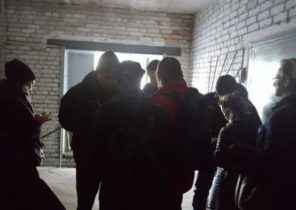The Soviet Union produced reinforced submarines that could sail faster, do more damage and dive deeper than their us counterparts, however, the naval forces of the United States were confident that their submarines had a distinct advantage over Soviet submarines because the last one was very noisy. In the case of a military confrontation between the two superpowers have more quiet U.S. submarines were more likely to detect Soviet submarine first — and to meet them with homing torpedoes. However, the confidence the U.S. Navy has weakened in the mid 1980-ies, when the Soviet Navy launched its nuclear submarine missile cruiser “Shark”. After more than 30 years, these submarines remain the backbone of the Russian fleet of nuclear attack submarines, and now they are much quieter than most American submarines.
The intelligence transmitted by the spies John Walker (John Walker) and Jerry Whitworth (Jerry Whitworth) in the 1970-ies, convinced the Soviet Navy in the need to make the next generation of submarines quieter. After many submarines of project 671 “Shchuka” (NATO — “Victor”) and expensive submarines with titanium hull of the project 945 “Barrakuda” (NATO — “Sierra”), in 1983, began construction of the first submarine of project 971 “Shchuka” (NATO — “Shark”). The new submarine was equipped with a modern multi-purpose instruments and computer control, imported from Japan and Sweden, which allowed Soviet engineers to establish a quiet seven-bladed screw.
This large submarine with underwater displacement of almost 13 thousand tons had a double steel hull, typical of many Soviet submarines that allowed her to gain more ballast water and be more resistant to damage. Rowing installing this shock submarines were installed so that their noise was played to drown out, and its external and internal surface covered with sound-absorbing sheets. Even memberborrowers holes through which water can pass inside the outer skin of the Shark was fitted with sliding shutters to minimise noise. This underwater vessel with a length of 111 meters it is equipped with elegant aquadynamics battle tower and the nacelle in the form of drops of water on the tail, where it was possible to place the passive sonar system. The crew numbers approximately 70 people can manage this sub for about 100 days.
Submarine class “Shark”, which was set pressurized water nuclear reactor with a capacity of 190 megawatts and could reach speeds of 33 knots (60 kilometres per hour) and operate at a depth of 480 meters, 200 meters deeper than the American submarines of class “Los Angeles”. However, the most alarming for the US Navy point was the fact that Shark was almost as inconspicuous as submarines of class “Los Angeles”. Now the Americans realized that the acoustic superiority anymore they are not guaranteed. On the other hand, it was believed that the sensors, which were equipped with “Sharks”, was weaker than the us.
Submarine “Shark-I” — in Russia they are called “Pike” — was intended primarily to “hunt” for submarines of the U.S. Navy, especially submarine missile cruisers. Four 533-millimeter torpedo tubes and four large 650-millimeter tubes are able to produce up to 40 torpedoes with steering-by-wire, mines, missiles 81РА “Blizzard” (NATO — SS-N-15 Starfish) anti-submarine missile RPK-6M “Waterfall” (NATO — SS-N-16 Stallion). “Pike” is also could carry up to 12 cruise missiles “Granat”, capable of striking land targets within a radius of up to 3 thousand kilometers.
Soviet shipyards produced seven submarines “Pike”, while the American fleet was engaged in a more subtle class of submarines of the “Seawolf”. Although the Soviet Union collapsed, in 1995, Russia launched the first of five advanced submarines of project 971 “Pike-B” — submarine “Vepr”, whose powerplant was equipped with a two-layer sound-absorbing system and a new system of sound location. Both submarines were six additional external torpedo tubes for launching missiles and torpedo decoys, and a new missile class ground-to-air “Strela-3”.
However, the most important improvement was to increase the level of stealth: new submarines are now significantly quieter than even the improved version of submarines of class “Los Angeles”, although some analysts said that the latter kept its low profile for high speeds. Currently, the U.S. Navy still 43 submarines of class “Los Angeles”, although 14 more new submarines of class “Seawolf” and “Virginia” ahead of “Shark” in terms of stealth.
Meanwhile, Russian shipyards continued to work to complete the process of creating a new and very expensive submarines of the “Akula-II”: according to some estimates in 1996, the cost of one submarine were 1.55 billion — equivalent in today’s money is $ 2.4 billion. The Russian economy is experiencing hard times, could not afford to maintain even those boats that were already built. In the end had to turn the construction of two submarines of the “Akula-II” and the other three turned into a underwater rocket cruisers of the class “Northwind”. As for the submarine “Vepr” that she was involved with the tragedy that occurred in 1998, when a mentally unbalanced young sailor killed eight crew members and threatened to blow up the torpedo Bay, then committed suicide.
After ten years of construction of the submarine “Gepard” is the only finished class submarine “Akula-III” was launched in 2001. They called it the culmination of Russian technologies “stealth”. Seven years later, Moscow has finally found the funds to complete the construction of the submarine class “Shark II” “seal” — after 15 years of delays. However, during the tests on the water in November 2008, for unknown reasons, the fire alarm went off, after which the submarine was filled with freon, which is used to extinguish fires. As a result, the barque, suffocated 20 people, mostly civilians, and it became one of the most serious incidents in the long and eventful history of submarine disasters.
After a long and costly repairs “seal” was ready to launch, and almost immediately after that India took its lease for 10 years, paying for it $ 950 million. The submarine was renamed “Chakra”, she was for many years the only nuclear submarine to India, and she was equipped with cruise missiles short range due to restrictions in accordance with the Regime of control over missile technologies. In October 2016, Moscow and new Delhi agreed to lease a second submarine class “Shark”, although it’s unclear whether it’s an older submarine “sperm Whale” or until the unfinished submarine “IRBIS” — given that the price of the rent reaches $ 2 billion, many experts believe that we are talking about the latter. This year, the submarine “Chakra” will be joined by submarines of class “Arihant” India’s production, which was created based on “Sharks” and are nuclear submarines with ballistic missiles on Board.
According to the publication Jane’s, today, the Russian Navy remains a 10-11 “Sharks”, but only 3 or 4 of them are in operating condition, and the others are awaiting repair. However, submarines of the Russian Navy are not without cause. In 2009 two submarines “the Shark” was spotted off the East coast of the United States. Three years later received unconfirmed information (this time the U.S. Navy has denied it) that another “Shark” spent a month in the Gulf of Mexico, undetected. According to some, the older the submarine “sperm Whale” “followed by a foreign submarine within 14 days.” All of these incidents strengthened the US Navy in the opinion that they should concentrate on anti-submarine weapons. Over the past few years, Russia has perfected the submarine “Shark”, to equip them with deadly cruise missiles “Caliber” that Russia fired from the submarine “Rostov-on-don” at targets in Syria in 2015.
Despite the low level of combat readiness of the submarines of “Shark”, they still remain the backbone of Russian Navy nuclear-powered missile cruisers and they will remain in service for at least another 10 years, i.e. until the moment when it begins to gain momentum the production of submarines of class “Ash”. Until that time, high levels of stealth submarines “Shark” will allow them to remain a major challenge for experts in anti-submarine warfare.
Sebastian Robin has a master’s degree at Georgetown University in the field of conflict resolution. He worked as a University instructor in the peace Corps in China. Robin regularly publishes articles on security issues and military history on the website War is Boring.







